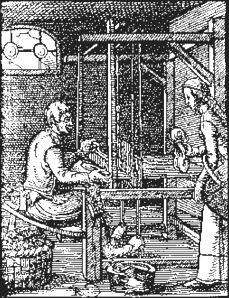The weaver
By the Renaissance weaving had become centralized, and was seldom done in the home.
Weavers (and tailors) were notorious for giving short measure, and cheating the customer. Speaking of the deceits of weavers, Robert Greene wrote:
[Your] woof and warp is so cunningly drawn out that you plague the poor country Huswives for their yarn, and. . . you make it seem both well wrought and to bear weight, when it is slenderly woven, and you have stolen a quarter of it from the poor wife.
(A Quippe for an Upstart Courtier)
The art of weaving tapestries was practiced throughout Europe; two fine examples are a "table carpet" or tablecloth, and the tapestries designed by Raphael for the Sistine Chapel and woven by the Brussels weaver, Pieter van Aelst, in the early sixteenth century.
